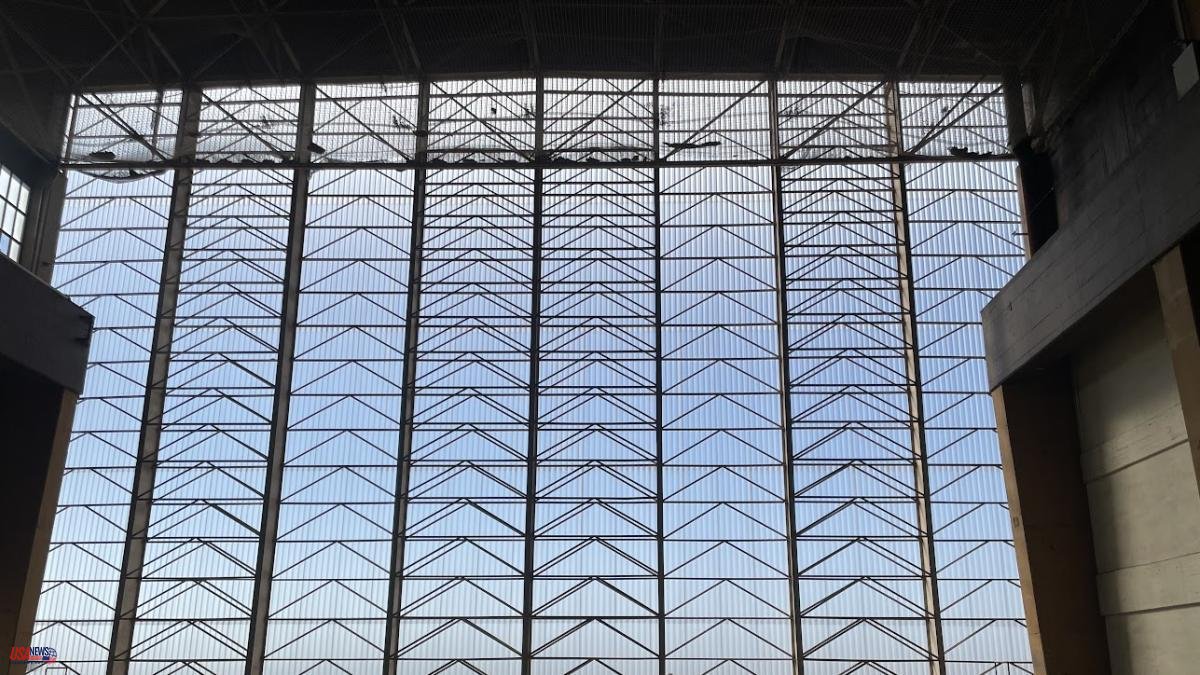2025 will be the year of Montserrat's millennium in Barcelona, while in 2026 the completion of the Sagrada Família will be celebrated with magnificence, coinciding with the international capital of architecture. Meanwhile, this 2024, a long-forgotten trident-shaped concrete mountain looms as a secular alternative to the Gaudi icon. At least, in terms of ascendancy on the Barcelona ladder. It is the old thermal spa of Sant Adrià de Besòs, popularly known as the three chimneys.
From September 8, the Manifesta art biennial will take possession of the building to offer various exhibitions and activities for three months. The thermal will come back to life for the first time after ceasing its activity in 2011. A group of international journalists visited this week with Manifesta. Vanguardia was there.
The organizers of the biennale (mostly women) will only be allowed to use 30% of the plant for artistic activities, but this includes more than half of the spectacular turbine room and the immediate surroundings of the building After having attended the previous edition of Manifesta in Pristina and seeing the mastery with which its leaders adapt post-industrial ruins to set up an artistic installation or a party, it is clear that the occupation of the three chimneys promises to be one of the big events of next summer in the city.
Work to minimally condition the site has begun these days. It is about installing lifts, securing floors and stairs and reinforcing railings, among other light works. Access will also be improved from the Sant Adrià train and tram stations, very close to the site.
The director of Manifesta 15, Hedwig Fijen, explains at the foot of the three imposing chimneys (two belong to Sant Adrià, and one to Badalona) that, in recent years, the biennale has incorporated purposes such as serving as incubator of a future with more social justice and more arguments against the climate crisis. Next to him, the architect Josep Bohigas, a member of Manifesta's board, encourages us to imagine the environment that this ruin will have when the plan agreed by the administrations materializes: a large park in front of the sea (the first to be built) and a new neighborhood where economic and residential activity will coexist.
In order to imagine the future, in any case, you need to know the past well. We thus enter the entrails of the beast, of such enormous dimensions that they are intimidating. This can be one of the great challenges of reusing the plant: mitigating with architectural solutions the distressing disproportion of this Pharaonic work.
With the art still absent (the chosen creators will be announced in April), the rooms remain paralyzed for days when an attack of premature obsolescence reduced them to ruin. In no other space is it more apparent than in the thermal control room to what extent the recent leap in technology has been dizzying. The telephone, monitors and switches are still used in the 21st century, but they evoke a sci-fi movie from the sixties or seventies. This scoreboard deserves to be preserved, whatever the use of the premises.
In principle, it is planned to locate Catalunya Media City, an audiovisual, digital and video game hub that requires an investment as exorbitant as the size of the building itself: 450 million euros. There are already 60 available to take the first steps. In Catalan audiovisuals, great expectations are placed on the three chimneys, although realism prevails. Sources in the sector recall that the same project integrates the Parc Audiovisual de Catalunya, in Terrassa, which is indeed developing at a good pace. The reform of the three chimneys (and the non-dismissable total or partial transfer of 3Cat-TV3 to the premises) must follow its course.
For the moment, those responsible for Manifesta have achieved something that seemed impossible: to bring down the walls of the castle and recover it in the name of art, even if it is for three months. One of them explains that the person who has helped them the most to achieve this is the architect Carme Ribas, manager of the Consorci del Besòs.
It would be desirable that, while waiting for the center, the cultural use of the thermal continues with ephemeral performances when Manifesta sets course for the next destination: Ruhr 2026. Of course, expectations must be moderated. Neither Barcelona is London nor the three chimneys will ever be the Tate Modern, no matter how many turbine rooms they share. But no human manifestation is better able than art to give meaning to this crazy truncated-conical corpse of almost 200 meters in height stranded on a Mediterranean beach. Where in the past the black rain that ruined the stretched clothes of the neighbors flowed, let the ideas flow at least.













